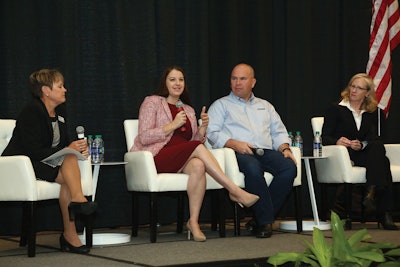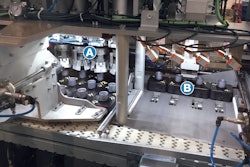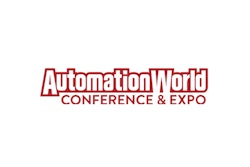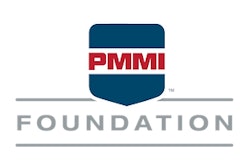The topic of how to attract more women to the field of manufacturing—and more specifically, to packaging and processing—has been top of mind for many industry executives as they struggle to find talent to fill a variety of company roles from engineering and operations on the factory floor to sales, marketing, and field support. While there are efforts underway to educate a younger generation on the opportunities available, it is becoming increasingly clear that there’s a bigger societal shift that must take place to create momentum for future generations.
Recently, Deloitte, APICS, and The Manufacturing Institute surveyed more than 600 women in manufacturing and conducted nearly 20 manufacturing executive interviews to explore how effectively manufacturing companies are attracting, recruiting, and retaining women, and what should be done to close the gender gap. The women surveyed as part of the Deloitte Women in Manufacturing Study 2017, are well-educated (90% hold a bachelor’s degree or above), experienced (71% have been working over 15 years), hold a variety of senior positions, and are employed by large companies (52% work in organizations with annual revenue over $1 billion).
So, what do women have to say? According to the report, given that women are underrepresented in manufacturing and the argument to increase female talent is persuasive, one thing is certain: Manufacturing companies need a different approach to recruiting, retaining, and advancing women in the workplace. And, that directly translates to a company’s culture as well as the industry as whole.
The executive interviews done for the report—conducted with both men and women—produced a handful of key things: Employee diversity makes good business sense; companies should identify the gaps between expectations and workplace reality; increasing visibility of women leaders is needed; attract qualified people early (because once they come, they stay); pay attention to the ‘group in the middle’ (retain and engage women at career points where work/life balance becomes complex; allies and advocates, at all levels and across genders, need to be identified and engaged.
It’s time to talk
Keeping these key points in mind, PMMI’s Packaging & Processing Women’s Leadership Network (PPWLN) held a breakfast panel at PACK EXPO International and Healthcare Packaging EXPO that brought together industry leaders for a candid conversation on how the industry can assist in building a diversified workforce.
The discussion, moderated by Jane Chase, executive director at the Institute of Packaging Professionals, included panelists Carol O’Neill, group president, packaging for Barry-Wehmiller; Hugh Roddy, vice president, global engineering and project management at Chobani; and AJ Jorgenson, associate vice president of strategic engagement at The Manufacturing Institute.
It was an energetic dialogue between the industry professionals and an interactive exchange with the audience (of over 500 attendees), who were encouraged to ask questions throughout the presentation. Chase kicked off the conversation with the question, “why do you feel women are underrepresented in manufacturing?”
“There’s a lot of history to overcome,” responded Barry-Wehmiller’s O’Neill. “The vision of what manufacturing is is that of a dark, dirty, heavy-lifting environment with pin-up calendars on the wall, and your role would be a cog in a wheel, which doesn’t sound exciting.”
The industry’s reputation is a clear obstacle, Chobani’s Roddy agreed, which is why the mindset of what manufacturing ‘is’ must change, and that must start early on in the education of young boys and girls. “Everyone has obstacles, male and female,” noting that his own upbringing in Ireland didn’t provide a full picture of the career opportunities, and, therefore, it wasn’t a goal of his to work in manufacturing as an electrical engineering, rather, he sort of just fell into it. But, he said, changing an industry starts with the individual. “It comes down to respect for everyone. I personally treat everyone with respect, whether they are putting a case on a pallet or sitting at the reception desk. Remember, they have lives outside of manufacturing and it’s important to feel good at work.”
The ability to balance work and life are also important—for men and women—which is why Chobani recently implemented a parenting policy that gives both mothers and fathers six weeks paid leave after the birth of a child or the arrival of foster or adopted children.
It’s a commendable program, but once parents are back to work, the equality must continue on the job. Jorgenson, who started her career at candy company Mars, Inc., before joining the National Association of Manufacturers (NAM), which is the parent organization to the Manufacturing Institute, is the mother of twins. Upon returning to work, many of her colleagues assumed she would not want to travel or run a major initiative, which was not the case. “It took our female president to say, ‘she’s been doing it successfully so far, let her do it’. The assumption is, if you have kids you’ve automatically ruled out a career.”
On the topic of career choice, Jorgenson noted that children of parents who work in manufacturing are three times more likely to get a job in manufacturing. Despite the great efforts by associations, corporations and colleges to introduce manufacturing as a career at the high school level, “they need to know by middle school, or even elementary school, what manufacturing is,” she said.
Dealing with discrimination
There were a few audience questions and comments around dealing with discrimination on the factory floor, or being dismissed by male colleagues, and sometimes even harassed. “Women have to work more to get half the level of respect of men,” noted one woman who recounted an incident when she was having a very technical work conversation with a male and he abruptly interrupted her to tell her she was beautiful. “How am I supposed to respond to that comment?”
Others in the audience and on the panel offered her some advice, including, find a mentor who can prepare you for those situations, but more importantly, make sure it is taken seriously by your team, even if it means having a difficult conversation with a customer.
“It’s really all of our responsibility to handle these situations when they happen,” O’Neill said. “We had a high level customer treat someone on our team with disrespect and his counterpart didn’t do anything to stop it. When I heard, we communicated back to the client and our team member on the spot that those comments must be discouraged and to not allow it to happen again.”
Whatever you do, don’t laugh it off, which only enables the behavior. “We have to change it,” Jorgenson said. “Create allies, so maybe it’s not you addressing it but another colleague saying ‘what did you just say to her?’ Create the right kind of atmosphere to call it out.”
Roddy reinforced that thought, noting that women should speak out as well as seek help from someone in the organization who understands. “Listening and mentorship go hand-in-hand,” Roddy said. “I’m an engineer and I sometimes look at things differently than others until someone once said to me, ‘just listen.’ Embrace change by listening to everyone on the plant floor to empower [the organization] from the ground-up.”
Ultimately, having more women on staff will help a company succeed. According to the Deloitte report, research shows that gender diversity benefits a manufacturing firm through improved ability to innovate, higher return on equity (ROE), and increased profitability. So when trying to change minds to change a culture, start with the facts.
“Fact, having more women on a team makes a company more profitable,” said Jorgenson.


























